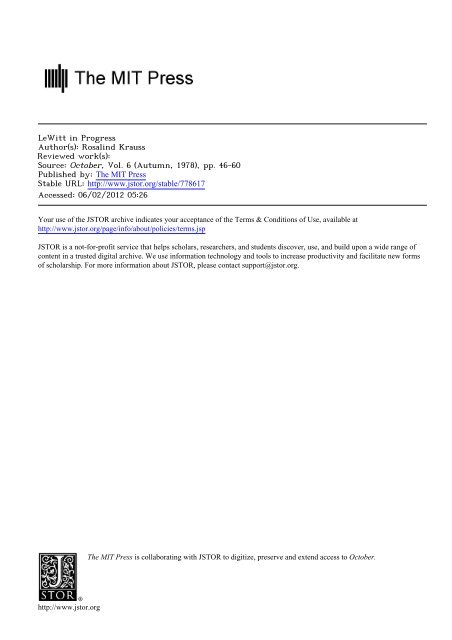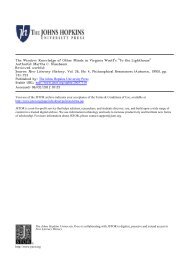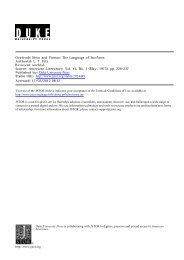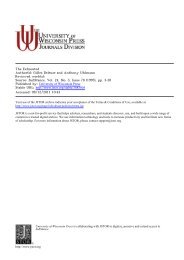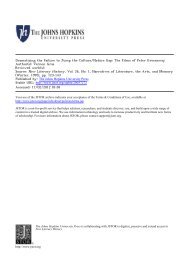Krauss-LeWitt in Progress - engl328
Krauss-LeWitt in Progress - engl328
Krauss-LeWitt in Progress - engl328
You also want an ePaper? Increase the reach of your titles
YUMPU automatically turns print PDFs into web optimized ePapers that Google loves.
<strong>LeWitt</strong> <strong>in</strong> <strong>Progress</strong><br />
Author(s): Rosal<strong>in</strong>d <strong>Krauss</strong><br />
Reviewed work(s):<br />
Source: October, Vol. 6 (Autumn, 1978), pp. 46-60<br />
Published by: The MIT Press<br />
Stable URL: http://www.jstor.org/stable/778617 .<br />
Accessed: 06/02/2012 05:26<br />
Your use of the JSTOR archive <strong>in</strong>dicates your acceptance of the Terms & Conditions of Use, available at .<br />
http://www.jstor.org/page/<strong>in</strong>fo/about/policies/terms.jsp<br />
JSTOR is a not-for-profit service that helps scholars, researchers, and students discover, use, and build upon a wide range of<br />
content <strong>in</strong> a trusted digital archive. We use <strong>in</strong>formation technology and tools to <strong>in</strong>crease productivity and facilitate new forms<br />
of scholarship. For more <strong>in</strong>formation about JSTOR, please contact support@jstor.org.<br />
http://www.jstor.org<br />
The MIT Press is collaborat<strong>in</strong>g with JSTOR to digitize, preserve and extend access to October.
ROSALIND KRAUSS<br />
<strong>LeWitt</strong> <strong>in</strong> <strong>Progress</strong><br />
The process of "algebrization," the over-automatization of an object,<br />
permits the greatest economy of perceptive effort. Either objects are<br />
assigned only one proper feature-a number, for example-or else they<br />
function as though by formula and do not even appear <strong>in</strong> cognition.<br />
Victor Shklovsky<br />
"Art as Technique"<br />
Consider the follow<strong>in</strong>g three documents: The first is an article entitled "Sol<br />
<strong>LeWitt</strong>-The Look of Thought," by the critic Donald Kuspit. The second is a<br />
book-length essay called <strong>Progress</strong> <strong>in</strong> Art by the artist and writer Suzi Gablik. The<br />
third is the critic Lucy Lippard's contribution to the catalogue for the <strong>LeWitt</strong><br />
retrospective at the Museum of Modern Art.<br />
Taken together these essays put forward a set of claims, addressed <strong>in</strong>itially to<br />
the work of a specific artist, but extended to the larger context of abstract art <strong>in</strong><br />
general, or at least to the abstract art of <strong>LeWitt</strong>'s generation. What these claims<br />
amount to is a declaration of the mission and achievement of this abstraction. It is,<br />
they collectively assert, to serve as triumphant illustration of the powers of human<br />
reason. And, we might ask, what else could Conceptual Art be?<br />
Kuspit signals this grand theme with the title of his essay. "The Look of<br />
Thought" is what stares back at us from the modular structures, the openwork<br />
lattices, the serial progressions of <strong>LeWitt</strong>'s sculputure. Thought, <strong>in</strong> Kuspit's<br />
terms, is deductive, <strong>in</strong>ferential, axiomatic. It is a process of f<strong>in</strong>d<strong>in</strong>g with<strong>in</strong> the<br />
manifold of experience a central, organiz<strong>in</strong>g pr<strong>in</strong>ciple; it is the activity of a<br />
transcendental ego.<br />
"In <strong>LeWitt</strong>," Kuspit writes, "there is no optical <strong>in</strong>duction; there is only<br />
deduction by rules, which have an axiomatic validity however much the work<br />
created by their execution has a tentative, <strong>in</strong>consequential look.' And, he<br />
cont<strong>in</strong>ues, "rationalistic, determ<strong>in</strong>istic abstract art l<strong>in</strong>ks up with a larger Western<br />
tradition, apparent <strong>in</strong> both classical antiquity and the Renaissance, viz., the<br />
Sol <strong>LeWitt</strong>. Floor Piece #4. 1976. Pa<strong>in</strong>ted wood, 43 1/4<br />
by 43 1/2 by 43 1/4 <strong>in</strong>ches.
_LI<br />
ffltSS0<br />
:igi:-_::-,':_:l:::::i:':iiil:i:i: II-<br />
L<br />
,,:j'iici:i:i.;i?i.itiii .:iiiii,:ii:iiiiiii?jX.:: '' ? ;0 : i t;0<br />
. k.'_<br />
.11 V t : 0-" ;<br />
40004 e-*A:', ; : 5;i??:fis: * e<br />
10X$0100AWl::;-:;::?-iil*04~<br />
?:::,::}:r::j0-::::j: _:;iji:: :: :-:i -::::::':11::-8--;i: i --:iii-,-l~li)i:iiii t0t0|<strong>in</strong>00tas.$0<br />
: _:400_0:;_0 'd~~~~~~~~~~~~~~~~~~~~~~~~~~~~~I-<br />
:i?l~ii~iiiiiiiii~iiiii _; _00 00_0_000<br />
if i--: j<br />
X<br />
i49<br />
f 7E<br />
V i<br />
19rn0; ii<strong>in</strong> wAt,00; IEEIIII uiia540SS,,;9 MIII i mut;<br />
00I'imiri0iC;;i;0<br />
f0; l5tw;X:- I u::. ::::X flaw; mim -X' G0; - =6i<br />
-. mat tat]0S uuEL<br />
A lsurni::i l0 X_4; E - :X %;P00 f0i 00 Urn
48<br />
OCTOBER<br />
pursuit of <strong>in</strong>telligibility by mathematical means. This tradition is profoundly<br />
humanistic <strong>in</strong> import, for it <strong>in</strong>volves the deification of the human m<strong>in</strong>d by reason<br />
of its mathematical prowess."<br />
The specific work <strong>in</strong> which Kuspit sees this deification of the human m<strong>in</strong>d <strong>in</strong><br />
operation is called Variations of Incomplete Open Cubes (1974). It is a modular<br />
structure composed of 122 units, each a member of a f<strong>in</strong>ite series, the series ordered<br />
<strong>in</strong> terms of a numerical progression. Throughout the series the "cube" as such is<br />
given only <strong>in</strong>ferentially, <strong>in</strong>itially by provid<strong>in</strong>g the least possible <strong>in</strong>formation<br />
(three edges set perpendicular to one another), and then progressively supply<strong>in</strong>g<br />
more of the miss<strong>in</strong>g edges, end<strong>in</strong>g with the greatest possible <strong>in</strong>formation (eleven<br />
edges). Each of the modules <strong>in</strong> the series is eight <strong>in</strong>ches on a side; each is pa<strong>in</strong>ted<br />
white; and the 122 skeletal structures are assembled on a vast platform.<br />
"The viewer," Kuspit <strong>in</strong>forms us, "completed the <strong>in</strong>complete cubes by<br />
mentally supply<strong>in</strong>g the miss<strong>in</strong>g edges, and experienced the tension between the<br />
literally unf<strong>in</strong>ished and the mentally f<strong>in</strong>ished cubes-between what Kant would<br />
call the phenomenal cube and the idea of the cube."2<br />
For almost no writer who deals with <strong>LeWitt</strong> is there any question that these<br />
geometric emblems are the illustration of M<strong>in</strong>d, the demonstration of rationalism<br />
itself. "At times," one critic writes, "the most elaborate of these constructions<br />
resemble translations of complete philosophical systems <strong>in</strong>to a purely formal<br />
language. If anyone could perceive the structural beauty of, say, Descartes's or<br />
Kant's treatises and then go on to recreate them as exclusively visual metaphor, it<br />
is surely <strong>LeWitt</strong>."3<br />
There may of course be readers of this k<strong>in</strong>d of criticism who balk at<br />
statements of this sort. They may f<strong>in</strong>d it strange that <strong>in</strong> the last quarter of the<br />
twentieth century there should have arisen an art dedicated to a triumphant<br />
Cartesianism, that when almost everyth<strong>in</strong>g else <strong>in</strong> our cultural experience has<br />
<strong>in</strong>structed us about the necessity of abandonn<strong>in</strong>g the fantasy of the transcendental<br />
subject, <strong>LeWitt</strong> should be capable of reassur<strong>in</strong>g us about its powers.<br />
For if I see myself putt<strong>in</strong>g to sea, and the long hours without landfall, I<br />
do not see the return, the toss<strong>in</strong>g on the breakers, and I do not hear the<br />
frail keel grat<strong>in</strong>g on the shore. I took advantage of be<strong>in</strong>g at the seaside<br />
to lay <strong>in</strong> a store of suck<strong>in</strong>g-stones. They were pebbles but I call them<br />
stones. Yes, on this occasion I laid <strong>in</strong> a considerable store. I distributed<br />
them equally among my four pockets, and sucked them turn and turn<br />
about.4<br />
But the power of human reason has captured the imag<strong>in</strong>ation of a number of<br />
contemporary writers on art, for whom abstraction is necessarily the outcome of<br />
1. Donald Kuspit, "Sol <strong>LeWitt</strong>: The Look of Thought," Art <strong>in</strong> America, LXIII (September-<br />
October 1975), 48.<br />
2. Ibid., p. 43.<br />
3. Robert Rosenblum, <strong>in</strong> Sol <strong>LeWitt</strong>, New York, The Museum of Modern Art, p. 14.<br />
4. Samuel Beckett, Molloy, New York, Grove Press, 1965, p. 69. All subsequent extracted passages<br />
appear on pp. 69-72.
Sol <strong>LeWitt</strong>. 122 Variations of Incomplete Open Cubes.<br />
1974. 122 structures, pa<strong>in</strong>ted wood, each 8 by 8 by 8<br />
<strong>in</strong>ches; base, 182 plywood squares, each 2 by 12 by 12<br />
<strong>in</strong>ches; 131 pen and <strong>in</strong>k draw<strong>in</strong>gs and photographs.<br />
(Installation, Museum of Modern Art, New York.)
50<br />
OCTOBER<br />
the triumphant progress of rationality. It is <strong>in</strong>structive, therefore, to th<strong>in</strong>k about<br />
the claims that are made for <strong>LeWitt</strong> <strong>in</strong> the context of a broader argument about the<br />
nature of abstraction. Suzi Galik's <strong>Progress</strong> <strong>in</strong> Art, for example, views the entire<br />
range of the world's visual culture as a problem <strong>in</strong> cognitive development. And<br />
abstract art, set with<strong>in</strong> this problematic, appears as the necessary fruits of some<br />
k<strong>in</strong>d of world <strong>in</strong>tellectual growth.<br />
Put very briefly, her argument is that the history of art divides <strong>in</strong>to three<br />
dist<strong>in</strong>ct periods, the first consist<strong>in</strong>g of all visual representation prior to the<br />
discovery of systematic perspective, the second, beg<strong>in</strong>n<strong>in</strong>g with the Renaissance,<br />
def<strong>in</strong>ed by the mastery of perspective, and the third, that of modernism, heralded<br />
by the onset of abstraction. As one might gather from the title of her book, the<br />
arthor's contention is that these divisions mark off stages <strong>in</strong> a radical progression,<br />
each stage outmod<strong>in</strong>g and supersed<strong>in</strong>g the one that came before it. The model for<br />
this idea of "progress <strong>in</strong> art" is that of human cognitive development, beg<strong>in</strong>n<strong>in</strong>g<br />
with the most childlike modes of thought and mov<strong>in</strong>g forward towards the greater<br />
complexity of operational, formal reason<strong>in</strong>g. Project<strong>in</strong>g this developmental<br />
model of the <strong>in</strong>dividual, taken from the work of Piaget, onto the entire corpus of<br />
world art, Gablik speaks of the history of styles as a matter of "advance"-a<br />
process of "evolution" towards stages of <strong>in</strong>creas<strong>in</strong>gly higher <strong>in</strong>tellectual organiza-<br />
tion. "The history of art exemplifies fundamental patterned pr<strong>in</strong>ciples of mental<br />
growth," she writes.5 Thus the Renaissance superseded all previous forms of<br />
representation because of the axiomatic, deductive nature of perspective, so that<br />
the space of the phenomenal world could be understood as unified by a system of<br />
coord<strong>in</strong>ates <strong>in</strong>dependent of "raw" perception. But the modern period (beg<strong>in</strong>n<strong>in</strong>g<br />
with Cubism) cognitively outdistances the Renaissance by withdraw<strong>in</strong>g this<br />
power of coord<strong>in</strong>ation from the real world entirely. In so do<strong>in</strong>g it demonstrates the<br />
<strong>in</strong>dependence of all deductive or logical systems from the process of observation.<br />
In Gablik's view the achievement of abstract art is its freedom from the demands of<br />
perceptual reality and its amibition to demonstrate what Piaget has termed the<br />
"formal-operational stage" of human th<strong>in</strong>k<strong>in</strong>g.<br />
This raised a problem which I first solved <strong>in</strong> the follow<strong>in</strong>g way. I had<br />
say sixteen stones, four <strong>in</strong> each of my four pockets these be<strong>in</strong>g the two<br />
pockets of my trousers and the two pockets of my greatcoat. Tak<strong>in</strong>g a<br />
stone from the right pocket of my greatcoat, and putt<strong>in</strong>g it <strong>in</strong> my<br />
mouth, I replaced it <strong>in</strong> the right pocket of my greatcoat by a stone from<br />
the right pocket of my trousers, which I replaced by a stone from the left<br />
pocket of my trousers, which I replaced by a stone from the left pocket<br />
of my greatcoat, which I replaced by the stone which was <strong>in</strong> my mouth,<br />
as soon as I had f<strong>in</strong>ished suck<strong>in</strong>g it.<br />
It is not surpris<strong>in</strong>g that <strong>LeWitt</strong>'s defenders would f<strong>in</strong>d much to admire <strong>in</strong> the<br />
thesis of <strong>Progress</strong> <strong>in</strong> Art. For an argument that draws a direct parallel between<br />
5. Suzi Gablik, <strong>Progress</strong> <strong>in</strong> Art, New York, Rizzoli, p. 147.
<strong>LeWitt</strong> <strong>in</strong> <strong>Progress</strong><br />
Piaget's "genetic epistemology" and the course of several millenia of aesthetic<br />
endeavor necessarily places artists of <strong>LeWitt</strong>'s generation at the "formal-<br />
operational stage" of development, as manipulators of a propositional logic far<br />
"<strong>in</strong> advance" of anyth<strong>in</strong>g that has come before it. Indeed, Lucy Lippard, <strong>in</strong> her<br />
essay for the Museum of Modern Art catalogue on <strong>LeWitt</strong>, claims that Gablik's<br />
description of this type of th<strong>in</strong>k<strong>in</strong>g applies most securely to the work of this artist.<br />
"It is only <strong>LeWitt</strong>'s 'reflective abstraction,'" Lippard ma<strong>in</strong>ta<strong>in</strong>s, "that fully fits<br />
<strong>in</strong>to these theories, only his work that can be said to articulate 'the moment <strong>in</strong><br />
artistic th<strong>in</strong>k<strong>in</strong>g when a structure opens to question<strong>in</strong>g and reorganizes itself<br />
accord<strong>in</strong>g to a new mean<strong>in</strong>g which is nevertheless the mean<strong>in</strong>g of the same<br />
structure, but taken to a new level of complexity.' "6<br />
Thus there were still four stones <strong>in</strong> each of my four pockets, but not<br />
quite the same stones. And when the desire to suck took hold of me<br />
aga<strong>in</strong>, I drew aga<strong>in</strong> on the right pocket of my greatcoat, certa<strong>in</strong> of not<br />
tak<strong>in</strong>g the same stone as the last time. And while I sucked it I<br />
rearranged the other stones <strong>in</strong> the way I have just described. And so on.<br />
In speak<strong>in</strong>g of Lippard and Kuspit as defenders of <strong>LeWitt</strong>'s work I do not<br />
mean to imply that anyone who disputes their view of it is automatically a<br />
detractor. Rather I am focus<strong>in</strong>g on a particular type of defense. It is one that<br />
undoubtedly f<strong>in</strong>ds its rhetorical force and psychological energy <strong>in</strong> reaction to the<br />
hostility that is generally directed at work like <strong>LeWitt</strong>'s. This hostility is rather<br />
muted <strong>in</strong>side the self-immured space of the art world, where <strong>LeWitt</strong> is considered a<br />
contemporary master, but outside those walls it is extremely pronounced. <strong>LeWitt</strong>'s<br />
white lattices, serially disposed or not, are viewed by the audience of a wider<br />
culture as baffl<strong>in</strong>g and mean<strong>in</strong>gless. For after all, what could they possible<br />
represent? To which the answer comes, as outl<strong>in</strong>ed above: they are representations<br />
of M<strong>in</strong>d. Freed at last from mak<strong>in</strong>g pictures of th<strong>in</strong>gs <strong>in</strong> the world, the artist is<br />
depict<strong>in</strong>g the cognitive moment as such.<br />
But this solution did not satisfy me fully. For it did not escape me that,<br />
by an extraord<strong>in</strong>ary hazard, the four stones circulat<strong>in</strong>g thus might<br />
always be the same four. In which case, far from suck<strong>in</strong>g the sixteen<br />
stones turn and turn about, I was really only suck<strong>in</strong>g four, always the<br />
same, turn and turn about.<br />
For these writers the cognitive moment has a particular form, assumes a<br />
particular shape. From the references to Descartes and the allusions to Euclidean<br />
diagrams, it is obvious that the form it takes is a k<strong>in</strong>d of center<strong>in</strong>g of thought-the<br />
discovery of a root pr<strong>in</strong>ciple, an axiom by which all the variables of a given system<br />
might be accounted for. It is the moment of grasp<strong>in</strong>g the idea or theorem that both<br />
generates the system and also expla<strong>in</strong>s it. Seen as be<strong>in</strong>g <strong>in</strong>terior to the system, and<br />
constitut<strong>in</strong>g the very ground of its unity, the center is also visualized as be<strong>in</strong>g<br />
6. Lucy Lippard, <strong>in</strong> Sol <strong>LeWitt</strong>, New York, The Museum of Modern Art, p. 27.<br />
51
52 OCTOBER<br />
above or outside it. Hence Kuspit's wish to l<strong>in</strong>k the idea of pure <strong>in</strong>telligibility,<br />
which he sees as the goal of <strong>LeWitt</strong>'s art, with the notion of transcendence.<br />
For no matter how I caused the stone to circulate, I always ran the same<br />
risk. It was obvious that by <strong>in</strong>creas<strong>in</strong>g the number of my pockets I was<br />
bound to <strong>in</strong>crease my chances of enjoy<strong>in</strong>g my stones <strong>in</strong> the way I<br />
planned, that is to say one after the other until their number was<br />
exhausted. Had I had eight pockets, for example, <strong>in</strong>stead of the four I<br />
did have, then even the most diabolical hazard could not have pre-<br />
vented me from suck<strong>in</strong>g at least eight of my sixteen stones, turn and<br />
turn about. The truth is I should have needed sixteen pockets <strong>in</strong> order<br />
to be quite easy <strong>in</strong> my m<strong>in</strong>d.<br />
But <strong>in</strong> stat<strong>in</strong>g the conditions by which abstract art might be freed from the<br />
obligation to picture the world, this k<strong>in</strong>d of critical argument merely substitutes a
<strong>LeWitt</strong> <strong>in</strong> <strong>Progress</strong><br />
new obligation. Abstract art is no longer tested by the faithfulness by which it<br />
transcribes appearances; it is now to be tested by its transparency to a different<br />
model. Visual reality no longer has a privileged status with relation to the work of<br />
art, no longer forms the text which the art is to illustrate. Now it is logic that<br />
constitutes the "text"; and the space onto which the art is now to open, the model<br />
it is to "picture" and by which it is to be tested is M<strong>in</strong>d.<br />
<strong>LeWitt</strong>'s art would, of course, fail this test. His math is far too simple; his<br />
solutions are far too <strong>in</strong>elegant; the formal conditions of his work are far too<br />
scattered and obsessional to produce anyth<strong>in</strong>g like the diagram of human reason<br />
these writers seem to call for.<br />
And for a long time I could see no other conclusion than this, that short<br />
of hav<strong>in</strong>g sixteen pockets, each with its stone, I could never reach the<br />
goal I had set myself, short of an extraord<strong>in</strong>ary hazard. And if at a pitch<br />
I could double the number of my pockets, were it only by divid<strong>in</strong>g each<br />
53
54 OCTOBER<br />
pocket <strong>in</strong> two, with the help of a few safety-p<strong>in</strong>s let us say, to quadruple<br />
them seemed to be more than I could manage. And I did not feel<br />
<strong>in</strong>cl<strong>in</strong>ed to take all that trouble for a half-measure. For I was beg<strong>in</strong>n<strong>in</strong>g<br />
to lose all sense of measure, after all this wrestl<strong>in</strong>g and wrangl<strong>in</strong>g, and<br />
to say, All or noth<strong>in</strong>g.<br />
Like most of <strong>LeWitt</strong>'s work, Variations of Incomplete Open Cubes provides<br />
one with an experience that is obsessional <strong>in</strong> k<strong>in</strong>d. On the vast platform, too<br />
splayed to be taken <strong>in</strong> at a glance, the 122 neat little fragmented frames, all<br />
meticulously pa<strong>in</strong>ted white, sit <strong>in</strong> regimented but mean<strong>in</strong>gless l<strong>in</strong>es, the demon-<br />
stration of a k<strong>in</strong>d of mad obst<strong>in</strong>acy. Quite unlike the diagrams <strong>in</strong> Euclid, where<br />
the axiomatic relationships are stated but once and the variety of possible<br />
applications left to the reader; or unlike the algebraic expression of the expansion
<strong>LeWitt</strong> <strong>in</strong> <strong>Progress</strong><br />
of a given series, where the formulaic is used precisely to foreclose the work<strong>in</strong>g out<br />
of every term <strong>in</strong> the series, <strong>LeWitt</strong>'s work <strong>in</strong>sistently applies its generative<br />
pr<strong>in</strong>ciple <strong>in</strong> each of its possible cases. The experience of the work goes exactly<br />
counter to "the look of thought," particularly if thought is understood as classical<br />
expressions of logic. For such expressions, whether diagramatic or symbolic, are<br />
precisely about the capacity to abbreviate, to adumbrate, to condense, to be able to<br />
imply an expansion with only the first two or three terms, to cover vast arithmetic<br />
spaces with a few ellipsis po<strong>in</strong>ts, to use, <strong>in</strong> short, the notion of etcetera. The babble<br />
of a <strong>LeWitt</strong> serial expansion has noth<strong>in</strong>g of the economy of the mathematician's<br />
language. It has the loquaciousness of the speech of children or of the very old, <strong>in</strong><br />
that its refusal to summarize, to use the s<strong>in</strong>gle example that would imply the<br />
whole, is like those feverish accounts of events composed of a str<strong>in</strong>g of almost<br />
identical details, connected by "and."<br />
55
56<br />
OCTOBER<br />
And while I gazed thus at my stones, revolv<strong>in</strong>g <strong>in</strong>term<strong>in</strong>able mart<strong>in</strong>-<br />
gales all equally defective, and crush<strong>in</strong>g handfulls of sand, so that the<br />
sand ran through my f<strong>in</strong>gers and fell back on the strand, yes, while thus<br />
I lulled my m<strong>in</strong>d and part of my body, one day suddenly it dawned on<br />
the former, dimly, that I might perhaps achieve my purpose without<br />
<strong>in</strong>creas<strong>in</strong>g the number of my pockets, or reduc<strong>in</strong>g the number of my<br />
stones, but simply by sacrific<strong>in</strong>g the pr<strong>in</strong>ciple of trim.<br />
But it is not entirely like those examples. For garrulousness, babble, the<br />
spasmodic hiccup of repetitious detail, have about them a quality of randomness,<br />
disorganization, a lack of system. And <strong>LeWitt</strong>'s outpour<strong>in</strong>g of example, his pil<strong>in</strong>g<br />
up of <strong>in</strong>stance, is riddled with system, shot through with order. There is, <strong>in</strong><br />
Variations of Incomplete Open Cubes, as they say, a method <strong>in</strong> this madness. For<br />
what we f<strong>in</strong>d is the "system" of compulsion, of the obsessional's unwaver<strong>in</strong>g<br />
ritual, with its precision, its neatness, its f<strong>in</strong>icky exactitude, cover<strong>in</strong>g over an abyss<br />
of irrationality. It is <strong>in</strong> that sense design without reason, design sp<strong>in</strong>n<strong>in</strong>g out of<br />
control. The obsessional's solutions to problems strike us as mad, not because the<br />
solutions are wrong, but because <strong>in</strong> the sett<strong>in</strong>g of the problem itself there is a<br />
strange short-circuit <strong>in</strong> the l<strong>in</strong>es of necessity.<br />
Now I am will<strong>in</strong>g to believe, <strong>in</strong>deed I firmly believe, that other<br />
solutions to this problem might have been found, and <strong>in</strong>deed may still<br />
be found, no less sound, but much more elegant, than the one I shall<br />
now describe, if I can. And I believe too that had I been a little more<br />
<strong>in</strong>sistent, a little more resistant, I could have found them myself. But I<br />
was tired, but I was tired, and I contented myself <strong>in</strong>gloriously with the<br />
first solution that was a solution, to this problem.<br />
<strong>LeWitt</strong> once expla<strong>in</strong>ed, "If I do a wall draw<strong>in</strong>g, I have to have the plan<br />
written on the wall or label because it aids the understand<strong>in</strong>g of the idea. If I just<br />
had l<strong>in</strong>es on the wall, no one would know that there are ten thousand l<strong>in</strong>es with<strong>in</strong><br />
a certa<strong>in</strong> space, so I have two k<strong>in</strong>ds of form-the l<strong>in</strong>es, and the explanation of the<br />
l<strong>in</strong>es. Then there is the idea, which is always unstated."7 The l<strong>in</strong>es are raw<br />
phenomena for which the label is not an explanation <strong>in</strong> the sense of a reason or an<br />
<strong>in</strong>terpretation, but an explanation <strong>in</strong> the sense of a documentary narrative or<br />
commentary, like a guide's tell<strong>in</strong>g his listener how high this particular redwood<br />
is, or how many years it took the Colorado River to cut the Grand Canyon. The<br />
label is the document of persistence, of <strong>in</strong>vention danc<strong>in</strong>g over the pit of non-<br />
necessity. And then, as <strong>LeWitt</strong> was fond of say<strong>in</strong>g, "there is the idea, which is<br />
always unstated."<br />
Sometimes, however, <strong>LeWitt</strong> did state the "idea." For <strong>in</strong>stance <strong>in</strong> 1969 he was<br />
to have an exhibition <strong>in</strong> Nova Scotia, and for this occasion he mailed the<br />
7. Lippard, p. 24.
<strong>LeWitt</strong> <strong>in</strong> <strong>Progress</strong><br />
directions for the work, along with the k<strong>in</strong>d of articulation that never appears on<br />
the wall-label: "A work that uses the idea of error, a work that uses the idea of<br />
<strong>in</strong>f<strong>in</strong>ity; a work that is subversive, a work that is not orig<strong>in</strong>al .. ." 8 These "ideas"<br />
exist on an entirely different order than that of the mathematical, the deductive,<br />
the axiomatic. If one uses the "idea of error" to generate a work, one has done<br />
someth<strong>in</strong>g quite different from illustrat<strong>in</strong>g an order that is ideated or Ideal, the<br />
order <strong>LeWitt</strong>'s critics keep <strong>in</strong>sist<strong>in</strong>g on associat<strong>in</strong>g with his art.<br />
But not to go over the heartbreak<strong>in</strong>g stages through which I passed<br />
before I came to it, here it is, <strong>in</strong> all its hideousness. All (all!) that was<br />
necessary was to put for example, to beg<strong>in</strong> with, six stones <strong>in</strong> the right<br />
pocket of my greatcoat, or supply-pocket, five <strong>in</strong> the right pocket of my<br />
trousers, and five <strong>in</strong> the left pocket of my trousers, that makes the lot,<br />
twice five ten plus six sixteen, and none, for none rema<strong>in</strong>ed, <strong>in</strong> the left<br />
pocket of my greatcoat, which for the time be<strong>in</strong>g rema<strong>in</strong>ed empty,<br />
empty of stones that is, for its usual contents rema<strong>in</strong>ed, as well as<br />
occasional objects. For where do you th<strong>in</strong>k I had my vegetable knife,<br />
my silver, my horn and the other th<strong>in</strong>gs that I have not yet named,<br />
perhaps shall never name.<br />
<strong>LeWitt</strong> did <strong>in</strong>deed write about ideas and how he wished to relate them to his<br />
work, when he declared that "the idea becomes a Mach<strong>in</strong>e that makes the art." 9 He<br />
also seemed to be address<strong>in</strong>g himself to an order superior to the merely visual<br />
when he used the word "conceptual" to characterize his work <strong>in</strong> two manifesto-<br />
like pronouncements he published <strong>in</strong> the late 1960s. And once the term was put <strong>in</strong><br />
play, "conceptual art" was like a ball that the art-world immediately ran with,<br />
driv<strong>in</strong>g deep <strong>in</strong>to the territory of Idealism. No Pythagorean dream was too exalted<br />
for this art not to be able to reflect it as visual metaphor, as diagramatic<br />
manifestations of the Real.<br />
But <strong>LeWitt</strong>'s "ideas" are not generally to be found <strong>in</strong> that high place. The<br />
k<strong>in</strong>d of idea he <strong>in</strong>evitably uses is subversive, address<strong>in</strong>g itself to the purposeless-<br />
ness of purpose, to the sp<strong>in</strong>n<strong>in</strong>g gears of a mach<strong>in</strong>e disconnected from reason.<br />
Robert Smithson spoke of this when he wrote, "<strong>LeWitt</strong> is concerned with<br />
ennervat<strong>in</strong>g 'concepts' of paradox. Everyth<strong>in</strong>g <strong>LeWitt</strong> th<strong>in</strong>ks, writes, or has made<br />
is <strong>in</strong>consistent and contradictory. The 'orig<strong>in</strong>al idea' of his art is lost <strong>in</strong> a mess of<br />
draw<strong>in</strong>gs, figur<strong>in</strong>gs, and other ideas. Noth<strong>in</strong>g is where it seems to be. His concepts<br />
are prisons devoid of reason." 10 <strong>LeWitt</strong> spoke of it also when he wrote, "Irrational<br />
thoughts should be followed absolutely and logically."" The consequence of<br />
obey<strong>in</strong>g this direction, and <strong>LeWitt</strong>'s art does obey it, is to arrive at the opposite of<br />
8. Ibid.<br />
9. Sol <strong>LeWitt</strong>, "Paragraphs on Conceptual Art," Artforum, V (June 1967), 80.<br />
10. Robert Smithson, "A Museum of Language <strong>in</strong> the Vic<strong>in</strong>ity of Art," Art International, March<br />
1968, 21.<br />
11. Sol <strong>LeWitt</strong>, "Sentences on Conceptual Art," Art-Language, no. 1 (May 1969), 11.<br />
57
58<br />
OCTOBER<br />
Idealism. It is to achieve an absurd Nom<strong>in</strong>alism-as we saw <strong>in</strong> Variations of<br />
Incomplete Open Cubes.<br />
Good. Now I can beg<strong>in</strong> to suck. Watch me closely. I take a stone from<br />
the right pocket of my greatcoat, suck it, stop suck<strong>in</strong>g it, put it <strong>in</strong> the<br />
left pocket of my greatcoat, the empty one (of stones). I take a second<br />
stone from the right pocket of my greatcoat, suck it, put it <strong>in</strong> the left<br />
pocket of my greatcoat. And so on until the right pocket of my<br />
greatcoat is empty (apart from its usual and casual contents) and the six<br />
stones I have just sucked, one after the other, are all <strong>in</strong> the left pocket of<br />
my greatcoat.<br />
The aesthetic manipulations of an absurdist nom<strong>in</strong>alism are hardly new<br />
with <strong>LeWitt</strong>. They appear everywhere throughout the production of M<strong>in</strong>imalism,<br />
beg<strong>in</strong>n<strong>in</strong>g <strong>in</strong> the very early '60s, and are of course to be found <strong>in</strong> the literature<br />
most venerated by that group of sculptors and pa<strong>in</strong>ters: the literature of the<br />
nouveau roman and of Samuel Beckett. To speak of what <strong>LeWitt</strong> shares expres-<br />
sively with his generation is not to dim<strong>in</strong>ish his art; rather it is to help locate the<br />
real territory of its mean<strong>in</strong>g.<br />
It is an absurdist Nom<strong>in</strong>alism, for <strong>in</strong>stance, that flattens the narrator's voice<br />
<strong>in</strong> Jealousy, as we are told of a grove of bannana trees through the pa<strong>in</strong>stak<strong>in</strong>g,<br />
persistent, sadistic description of its <strong>in</strong>dividual rows. The effect is of course to<br />
drive attention away from the grove of trees and back to the voice and its obsession<br />
to count.<br />
Paus<strong>in</strong>g then, and concentrat<strong>in</strong>g, so as not to make a balls of it, I<br />
transfer to the right pocket of my greatcoat, <strong>in</strong> which there are no stones<br />
left, the five stones <strong>in</strong> the right pocket of my trousers, which I replace by<br />
the five stones <strong>in</strong> the left pocket of my trousers, which I replace by the<br />
six stones <strong>in</strong> the left pocket of my greatcoat. At this stage then the left<br />
pocket of my greatcoat is aga<strong>in</strong> empty of stones, while the right pocket<br />
of my greatcoat is aga<strong>in</strong> supplied, and <strong>in</strong> the right way, that is to say<br />
with other stones than those I have just sucked. These other stones I<br />
then beg<strong>in</strong> to suck, one after the other, and to transfer as I go along to<br />
the left pocket of my greatcoat, be<strong>in</strong>g absolutely certa<strong>in</strong>, as far as one<br />
can be <strong>in</strong> an affair of this k<strong>in</strong>d, that I am not suck<strong>in</strong>g the same stones as<br />
a moment before, but others.<br />
And the passage from Molloy about the suck<strong>in</strong>g stones is one of many<br />
possible <strong>in</strong>stances from Beckett <strong>in</strong> which the gears of rationc<strong>in</strong>ation proceed to<br />
sp<strong>in</strong> <strong>in</strong> an extraord<strong>in</strong>ary performance of "th<strong>in</strong>k<strong>in</strong>g," where it is clear that the<br />
object of this "thought" is entirely conta<strong>in</strong>ed with<strong>in</strong> the brilliance of the rout<strong>in</strong>e.<br />
It is like music-hall performers do<strong>in</strong>g a spectacular turn, switch<strong>in</strong>g hats from one<br />
head to the other at lightn<strong>in</strong>g speed. No one th<strong>in</strong>ks of the hat as an idea: it is
Sol <strong>LeWitt</strong>. Come and Go. Draw<strong>in</strong>g for play by<br />
Samuel Beckett, Harper's Bazaar, April 1969. Pen and<br />
<strong>in</strong>k, 18 by 22 1/4 <strong>in</strong>ches.
60<br />
OCTOBER<br />
simply a pretext for a display of skill-as is the "problem" of the stones. It is the<br />
ironical presence of the false "problem" that gives to this outburst of skill its<br />
special emotional tenor, its sense of its own absolute detachment from a world of<br />
purpose and necessity, its sense of be<strong>in</strong>g suspended before the immense spectacle<br />
of the irrational.<br />
For <strong>LeWitt</strong>'s generation a false and pious rationality was seen uniformly as<br />
the enemy of art. Judd spoke of his own k<strong>in</strong>d of order as be<strong>in</strong>g "just one th<strong>in</strong>g<br />
after another." Morris and Smithson spoke of the joy of destruction. For this<br />
generation the mode of expression became the deadpan, the fixed stare, the<br />
un<strong>in</strong>flected repetitious speech. Or rather, the correlatives for these modes were<br />
<strong>in</strong>vented <strong>in</strong> the object-world of sculpture. It was an extraord<strong>in</strong>ary decade <strong>in</strong> which<br />
objects proliferated <strong>in</strong> a seem<strong>in</strong>gly endless and obsessional cha<strong>in</strong>, each one<br />
answer<strong>in</strong>g the other-a cha<strong>in</strong> <strong>in</strong> which everyth<strong>in</strong>g l<strong>in</strong>ked to everyth<strong>in</strong>g else, but<br />
noth<strong>in</strong>g was referential.<br />
To get <strong>in</strong>side the systems of this work, whether <strong>LeWitt</strong>'s or Judd's or<br />
Morris's, is precisely to enter a world without a center, a world of substitutions<br />
and transpositions nowhere legitimated by the revelations of a transcendental<br />
subject. This is the strength of this work, its seriousness, and its claim to<br />
modernity. To give accounts of this k<strong>in</strong>d of art that misconstrue its content, that<br />
entirely misplace the ground of its operations, is to <strong>in</strong>vent a false justification of<br />
the work which traduces and betrays it. Aporia is a far more legitimate model for<br />
<strong>LeWitt</strong>'s art than M<strong>in</strong>d, if only because aporia is a dilemma rather than a th<strong>in</strong>g.


